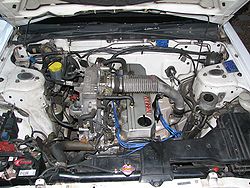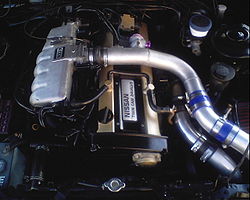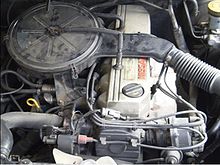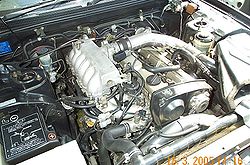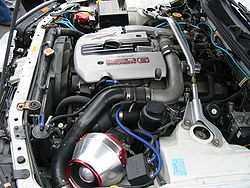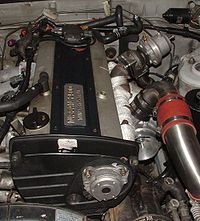- Nissan RB engine
-
The RB engine is a 2.0–3.0 L straight-6 four-stroke petrol/gasoline engine from Nissan produced from 1980-2004. A special limited edition the LMRB26 was also built during this time by General Motors in Australia.
Both SOHC and DOHC versions have an aluminium head. The SOHC versions have 2 valves per cylinder and the DOHC versions have 4 valves per cylinder; all cam lobes move only one valve. All RB engines have belt-driven cams and a cast iron block. Most turbo models have an intercooled turbo (the exceptions being the single cam RB20ET & RB30ET engines), and most have a recirculating factory blow off valve (the exceptions being when fitted to Laurels and Cefiros) to reduce boost surge when the throttle is closed.
The Nissan RB Engine is derived from the six cylinder Nissan L20A engine which has the same bore and stroke as the RB20.
Contents
Bore and stroke
All Nissan engines follow a naming convention, identifying the engine family (in this case, RB), displacement, and features present- see the list of Nissan engines for detail.
The stock dimensions for the RB engines;
- RB20 - 2.0 L (1998 cc, bore: 78.0 mm, stroke: 69.7 mm)
- RB24 - 2.4 L (2428 cc, bore: 86.0 mm, stroke: 69.7 mm)
- RB25 - 2.5 L (2498 cc, bore: 86.0 mm, stroke: 71.7 mm)
- RB26 - 2.6 L (2568 cc, bore: 86.0 mm, stroke: 73.7 mm)
- RB30 - 3.0 L (2962 cc, bore: 86.0 mm, stroke: 85.0 mm)
- "D" indicates a dual overhead cam as opposed to a single overhead cam
- "E" indicates the engine is electronically fuel-injected
- "S" indicates the engine is carburetted
- "T" indicates the engine has a factory installed turbocharger
- "TT" indicates the engine has factory installed twin turbochargers
RB20
There were a variety of 2.0 L RB20 engines produced:
- RB20E - single-cam (96 to 110 kW (130 to 145 ps) @ 5600 rpm, 167 to 181 N·m (17 to 18,5 kgf·m) @ 4400 rpm)
- RB20ET - single-cam turbocharged (125 kW (170 PS) @ 6000 rpm, 206 N·m (21.0 kgf·m) @ 3200 rpm)
- RB20DE - twin-cam (110 to 114 kW (150 to 155 PS) @ 6400 rpm, 181 to 186 N·m (18.5 to 19 kgf·m) @ 5600
- RB20DET - twin-cam turbocharged (158 kW (215 PS) @ 6400 264 N·m (27.0 kgf·m) @ 3200 rpm)
- RB20P - single-cam (94 PS @5600 rpm and 142 N·m @2400 rpm)
- RB20DET-R - twin-cam turbocharged (210 ps @6400 rpm and 245 N·m @4800 rpm
- NEO RB20DE - twin-cam 155 PS, improved low end torque, reduced fuel consumption and emissions.
The first RB20E/ET/DE/DET engines were fitted to the HR31 Skyline. The early twin cam engines are generally referred to as 'Red Top' engines because they have red cam covers. The early twin cam engines featured the NICS (Nissan Induction Control System) injection system, while the later twin cam engines used ECCS (Electronically Controlled Combustion System). Later versions which used ECCS engine management, discarded the twelve tiny runners for six much larger ones (though they retained twelve ports on the head, so there was a splitter plate). The RB20E was also fitted to some Holden Commodores (the VL Commodore) sold in New Zealand, and also to the A31 Cefiro and C33 Laurel. The Z31 200ZR was fitted with an intercooled NICS type RB20DET. RB20DET Red top Camshaft duration 248°in, 240°ex lift: 7.8mm in, 7.8mm ex
Laurels, R32 Skyline and Cefiros used the second (1989-1993) series RB20E/DE/DET. This had an improved head design, and used the ECCS injection system. These later motors are known as 'Silver Top' engines.
RB20DE Camshaft duration 232° in, 240° ex lift: 7.3mm in, 7.8mm ex RB20DET Camshaft duration 240°in, 240°ex lift: 7.3mm in, 7.8mm ex
The RB20DET-R was used in the Nissan Skyline 2000GTS-R (HR31). It is limited to 800 units.The RB20P is the autogas LPG (Liquefied petroleum gas) version of the RB20, but with 12 valves (OHC).
RB24S
This is a very rare engine, as it was not produced for the Japanese domestic market. These were fitted to some left hand drive Nissan Cefiros exported from Japan new. Mechanically, the RB24S combines an RB30E head, RB25DE/DET block and RB20DE/DET crank with 34 mm height pistons. The resulting 86.0 mm bore and 69.7 mm stroke combined to form a 2,428 cc inline-six engine.
This engine used carburettors instead of the Nissan ECCS fuel injection system. It is able to rev harder than the RB25DE/DET (as it has the same stroke as the RB20DE/DET) as well as being almost the same displacement as the RB25DE/DET. A common modification is to fit a twin cam head from other RB series motors while retaining the carburettor set-up. The standard single cam form produced 141 PS at 5,000 rpm and 20.1 kgf·m (197 N·m) of torque at 3,000 rpm.
RB25
The 2.5 L RB25 engine was produced in four forms:
- RB25DE - NON-TURBO twin-cam 140 kW/190 PS (180 - 200hp ) @ 6000 rpm, 255 N·m (26.0 kgf·m) @ 4000 rpm)
- RB25DET - twin-cam TURBO (T3 Turbo) (245 to 250 hp and 319 N·m)
- NEO RB25DE- NON-TURBO twin-cam 147 kW/200 PS @ 6000 rpm, 255 N·m (26.0 kgf·m) @ 4000 rpm)
- NEO RB25DET - twin-cam TURBO (206 kW (280 PS) @ 6400 rpm, 362 N·m (37.0 kgf·m) @ 3200 rpm)
RB25DE and DET engines produced from August 1993 also featured NVCS (Nissan Variable Cam System) for the intake cam. This gave the new RB25DE more power and torque at lower rpm than the previous model. From 1995, both the RB25DE and RB25DET had a revised electrical system and the turbo charger on the RB25DET had a plastic compressor wheel rather than aluminium. Generally these engines are referred to as Series 2 engines. The most obvious change to the system was the introduction of ignition coils with built in ignitors, therefore the coil ignitor that was on previous models was not used. Other changes were, different air flow meter, engine ecu, cam angle sensor and throttle position sensor. Mechanically series 1 and series 2 are exactly the same.
In May 1998 a NEO head was fitted, which enabled the engine to be classified as a low emission vehicle (LEV) engine due to their lower fuel consumption and emission output. The NEO head featured solid lifters rather than hydraulic, revised camshafts and a revised inlet manifold, in particular the RB25DE NEO which had 2 inlets going into the inlet manifold. The combustion chamber of the head is smaller, so GT-R spec connecting rods are used to compensate. The turbo received the larger OP6 turbine.
The non-VCT, non-turbo RB25DE was fitted to the R32 Skyline, the VCT turbo and non-turbo was fitted to R33 Skylines and the WC34 Stagea. Early R34 Skylines use the non NEO RB, later models use the NEO version.R32 Skyline RB25DE Camshaft duration 240°in, 232°ex lift: 7.8mm in, 7.3mm ex
R33 Skyline RB25DE Camshaft duration 240°in, 240°ex lift: 7.8mm in, 7.8mm ex
RB25DET Camshaft duration 240°in, 240°ex lift: 7.8mm in, 7.8mm ex
RB25DE NEO Camshaft duration 236°in, 232°ex lift: 8.4mm in, 6.9mm ex
RB25DET NEO Camshaft duration 236°in, 232°ex lift: 8.4mm in, 8.7mm ex
RB26DETT
The RB26DETT engine is a 2.6L Inline-6 engine manufactured by Nissan, for use primarily in the 1989-2002 Nissan Skyline GT-R. The RB26DETT engine block is made from cast iron, and the cylinder head is made from aluminium. The cylinder head contains 24 valves (4 valves per cylinder), and uses a dual overhead camshaft setup. The intake of the RB26DETT varies from other RB-series motors in that it has six individual throttle bodies instead of a single throttle body. The engine also uses a parallel twin-turbo system. The turbo system is arranged so that the front turbo is powered by the front 3 cylinders, and the rear turbo is powered by the rear 3 cylinders. The RB26DETT uses a pair of T28-type ceramic turbochargers that are set by the wastegates to limit boost pressure to 10 psi, although the Skyline GT-R has a built in boost restrictor to keep boost under 14 psi.
The first 2.6 L RB26DETT featured twin-turbochargers and produced around 280 HP (206 kW) @ 6800 rpm and 260 ft•lb (353 N•m) @ 4400 rpm. The last series of the RB26DETT produced 280 PS (206 kW) @ 6800 rpm and 289 ft•lb (392 N•m) @ 4400 rpm. } The reason for this discrepancy is a gentlemen's agreement between Japanese automakers to limit the advertised horsepower of any vehicle to 280 PS (276HP). It is widely known for its strength and extreme power potential. It is not uncommon for 600 hp to be achieved without modification of the engine internals. With regular maintenance, many of these engines have been driven well beyond the 100,000 mile mark with a few heading toward 200,000 miles. With extreme modification, the RB26 motor is capable of power in excess of 1 megawatt (or over 1,340 hp).[1][2] (*Note: The KA24DE has been proven to make in excess of 1100whp with "extreme modification")
RB26DETT Camshaft duration 240°in, 236°ex lift: 8.58mm in, 8.28mm ex RB26DETT N1 Camshaft duration 240°in, 236°ex lift: 8.58mm in, 8.28mm ex
There is a common oiling problem with the pre-1992 R32 RB26 motors, as the surface where the crankshaft meets the oil pump was machined too small, eventually leading to oil pump failure at high rpm. This issue was resolved in later versions of the RB26. Aftermarket performance parts makers also make oil pump extension drives to rectify this problem.
Originally the R32 GT-R was planned to have a 2.4L RB24DETT, and compete in the 4000 cc class (in Group A rules, the displacement is multiplied by 1.7 if the engine is turbocharged). This was when Nismo was going through the process of designing the R32 GT-R to be a Group A race car. But when the engineers added the AWD system, it would make the car heavy and less competitive. Nismo made the decision to make the engine a 2.6L twin turbo, and compete in the 4500 cc class, resulting in the RB26DETT known today.[3]
The RB26DETT was used in the following cars:
- Nissan Skyline GT-R BNR32
- Nissan Skyline GT-R BCNR33
- Nissan Skyline GT-R BNR34
- Nissan Stagea 260RS WGNC34改
- Nissan Skyline GT-R BCNR33 AUTECH Var.
RB26DETT N1
The RB26DETT N1 is a modified version of the RB26DETT engine, developed by Nismo (Nissan Motorsports) for Group A and Group N motorsport. Nismo found that the standard RB26DETT engine required too much maintenance for use in a Group-A or Group-N race car and consequently designed the N1 block. This was first used in Bathurst Australia. Nismo balanced the crankshaft to a higher specification than stock, as the RB26DETT engine experiences vibrations between 7000 and 8000 rpm. The engine also received improved water and oil channels within the engine block. The pistons and top piston rings were also upgraded to 1.2 mm. The N1 engine also has upgraded camshafts and upgraded turbochargers.
Although all versions of the RB26DETT N1 engine use Garrett T25 turbochargers, the specification of the turbochargers changed through the 3 generations of the RB26DETT N1 engine (R32, R33, and R34). The R32, and R33 versions used Journal Bearing T25 Turbochargers. The R34 RB26DETT N1 engine used Garrett GT25 turbo chargers (which use a Ball Bearing).
The biggest difference between the turbochargers used in the N1 engine, and the standard RB26DETT engine, is that the Turbine Wheels in the turbocharger are made from Steel, rather than the Ceramic used for the Standard RB26DETT turbochargers. The Ceramic turbine wheels are found to be very unreliable when used at high rotational speeds inducing higher centrifugal forces (such as when the turbochargers are used at a higher boost pressure than stock). With the advances in manufacturing technology such as sealing and material processes, the N1 engine is theoretically said to be able to produce in excess of 1,900 bhp (1,400 kW)
The Nismo RB26DETT N1 Engine Block uses an 86 mm bore which can be bored up to either 87 mm or 88 mm. The N1 block is stamped with an identification mark of 24U, or 25U, whereas the standard RB26DETT block is marked with 05U. The RB26DETT N1 block is compatible with all GT-R engine bays.
Only two R32 GTR Bathurst cars were stripped after the competition. Parts were shipped back to Japan where it's believed some were sold to private parties in New Zealand and Australia.
RB26DETT Z2
This is the engine used in the Nissan Skyline GT-R Z-Tune. It uses the stronger RB26 N-1 block, modified with Nismo parts, bored and stroked to 2.8 L (87.0 x 77.7 mm). The end result was the RB28Z2, which produces 510 bhp (368 kW) and 540 N·m of torque.[4]
RB30
Four models of 3.0 L RB30 were produced from 1987 - 1991:
- RB30S - carburetted single-cam
- RB30E - fuel-injected single-cam (114 kW at 5,200 rpm, 247 N·m (25.2 kgf·m) at 3,600 rpm)
- RB30E R31 Skyline - fuel-injected single-cam (117 kW at 5,200 rpm, 252 N·m (25.2 kgf·m) at 3,600 rpm)
- RB30ET VL Commodore - fuel-injected single-cam turbo (150 kW at 5,600 rpm, 296 N·m at 3,200 rpm)
This motor was produced for use in the Skylines, Patrols and rights bought by Holden because the Holden 202 (3.3 L) powering the Holden Commodore could no longer satisfy tightening emissions requirements, and with all new cars required to run on unleaded petrol by 1986 a quick replacement was needed. Nissan Motor Co. sold the RB30E to Holden for the VL Commodore. Because the radiator is fitted lower in relation to the engine in the VL, there is an increased likelihood of air locks forming in the (alloy) cylinder head, causing this to overheat and warp. This was less likely in the R31 Skyline as the radiator is mounted higher.[5] The engine proved to be very reliable apart from this issue. The RB30S was found in some Middle Eastern R31 Skylines and in some Nissan Patrols. The RB30E was found in R31 Skylines and VL Commodores in Australia as well as in South African R31 Skylines (with 126 kW at 5,000 rpm and 260 Nm at 3,500 rpm)
The turbocharged RB30ET (producing 150 kW) was found only in the VL Commodore (available in all models) and consisted of a lower compression RB30E bottom end, more powerful oil pump, T3 Garrett turbocharger, 250 cc injectors and a different intake manifold. The motor itself is still popular today (albeit in highly modified form) on the Australian Drag Racing circuit.
Nissan Special Vehicles Division Australia produced two limited models of R31 Skylines, the GTS1 and GTS2. These contained slightly more powerful RB30E engines, containing longer opening duration cams and better flowing exhausts.
- GTS1 RB30E - injected single-cam (130 kW at 5,500 rpm, 255 Nm (26.0 kgf·m) at 3,500 rpm) - special cam profile, special exhaust[6]
- GTS2 RB30E - injected single-cam (140 kW at 5,600 rpm, 270 N·m (27.5 kgf·m) at 4,400 rpm) - special cam profile, special exhaust, piggy back computer, valve porting[7]
RB30DE
These rare engines were used in the Tommy Kaira M30 based on the R31 Skyline GTS-R. A modified RB20DE head was bolted on to the RB30E block. It delivered 177 kW (240 PS) @ 7000 rpm and 294 N·m (30.0 kgf·m) @ 4800 rpm.
RB30DET
Nissan did not produce this engine, but it refers to a turbocharged engine featuring an RB30E block with a twin-cam head conversion. Common hybrid in Australasia (referred to as the RB25/30 or RB26/30) using a RB30E bottom end mated to a RB25DE,RB25DET or RB26DETT cylinder head and turbo (RB20DE and DET heads are not used as the bores are different in size; RB30 86.0 mm RB20 78.0 mm but were originally modified and used on the Tommy Kaira RB30DE as the RB25 engine did not exist). The RB25DE cylinder head from the A31 Cefiro C33 Laurel or R32 skyline (aka: Non VCT) can be used, and fits perfectly on (although better valve springs are recommended, GT-R valve springs are a decent upgrade). The RB25DET (from the R33 Skyline or C34 Laurel or Stagea) head is also used, however an external oil feed must be fabricated for the variable cam timing (VCT) on the RB25DET, and the galleries at the front of the engine do not line up. The variable cam timing may be disconnected altogether.Also it is wise to change the oil restrictors in the block to 1.5mm and get a full face oil pump drive collar machined onto the crank(solves it shattering at high RPM) with the use of a twin cam oil pump.
The fitment of a twin cam head from any of these engines onto a standard compression RB30E bottom end gives an ideal compression ratio for a mild to moderately modified street turbo engine around 8.2:1, (but always check your compression when building this engine as it may vary), making the conversion popular amongst those who would otherwise convert their RB30E to a high compression RB30ET using original ET bolt on externals.
Although it has a larger displacement than the RB26DETT, maximum possible horsepower is less, as the RB30 block lacks the RB26 block's internal cast-in bracing, and consequently cannot rev as high due to harmonic issues at ~7500 rpm. To compensate, the RB30DET produces more torque at lower revs due to its longer stroke. However they have been known to reach engine speeds up to 11,000 rpm with a lot of balancing and the use of the RB26 head with solid lifters. Power of the RB30DET in this form can far exceed that of an RB26DETT, RB30DET's are usually only found in RWD cars as it's a lot easier to install, with the 4wd setup in the GTR or GTS4 an adapter plate has to be made to fit the 4WD sump as its bolt pattern is different to the RB30, as there is a adapter plate between the sump it sits off on the gearbox bolt holes, they will have to be modified to fit.
There is also an 'RB30DETT' kit manufactured by OS Giken of Japan, which bolts an extension on top of the RB26 engine block, and fits liners, to give an 86 mm bore x 86 mm stroke. It is available as an assembled short block, containing billet chrome-molybdenum crank, billet chrome-molybdenum H-beam connecting rods, forged pistons, and costs ¥1,500,000.[8]
RB-X GT2 & RB28DET
The RB-X GT2 (designed and built by REINIK) is an engine specially made for the Nismo 400R. The difference between this engine and a RB26DETT is that the engine is bored and stroked (87.0 × 77.7 mm) which results in 2771 cc. Engine produces 450 PS (331 kW or 443 HP) at 6800 rpm and 47.8 kgf·m (469 N·m or 347 lbf·ft) at 4400 rpm.[9] This engine was manufactured with a reinforced cylinder block and cylinder head, metal head gasket, pistons with cooling channels, forged crank shaft, forged connecting rods, N1 turbine with reinforced actuator, high flow air cleaner, stainless down pipe, and low air resistance sport catalyzer, most of which were not offered for the RB26DETT. RB-X GT2 engines competed in LeMans 24hr race, Pikes Peak, and other forms of motorsports. GT500 and Z-tune engines are also based on REINIK's design although now built by NISMO's Omori Factory. REINIK also made over 20 RB28DET based on the R33 RB25DET. These engines were ordered by Prince Nissan Dealership network for a special edition R33 GT25t called 280 Type-MR. The engine was build for high torque and limited to 300 PS.
Notes
- ^ Turbo and High-tech Performance #186. July 2006.
- ^ "Ex Vi Termini : GTR-700 specifications". http://www.exvitermini.com/r33specs.htm. Retrieved 2006-08-24.
- ^ [that received an exhaust flow out put og 3.2.1 which flowed better than the r33 and r34http://ja.wikipedia.org/wiki/RB26DETT "Japanese Wikipedia on RB26DETT"] (in Japanese). that received an exhaust flow out put og 3.2.1 which flowed better than the r33 and r34http://ja.wikipedia.org/wiki/RB26DETT. Retrieved 2007-01-06.
- ^ "Nismo R34 Z-Tune description on Nismo website" (in English). http://www.nismo.co.jp/Z-tune/contents_e.html. Retrieved 2007-08-30.
- ^ http://www.carpoint.com.au/reviews/2004/medium-passenger/holden/commodore/holden-vl-commodore-198688-3482
- ^ Cleary, James (November 1988). Modern MOTOR (Australia). pp. 36–41. "A new camshaft profile and modified exhaust combine to give the GTS 130 kW of power at 5500 rpm and 255 N·m of torque at 3500 rpm."
- ^ Car Australia. October 1989. pp. 58–63. "Power is up to 140 kW over the stock car's 114 kW..."
- ^ "OS Giken RB30 Kit" (in Japanese). http://www.osgiken.co.jp/pro_spec/rb30kit.html. Retrieved 2006-05-21.
- ^ "Nismo 400R specification on Nismo website" (in Japanese). http://www.nismo.co.jp/complete/400R/spec2.html. Retrieved 2007-08-30.
See also
- List of Nissan engines
- Nissan
Nissan Motor Company Vehicles Current370Z • Advan • Altima • Aprio • Armada • Atlas • Bluebird • Bluebird Sylphy • Cabstar • Caravan • Civilian • Clipper • Cube • Dualis • Elgrand • Frontier • Freeson • Fuga • GT-R • Juke • Lafesta • Leaf • Livina Geniss • Maxima • March • Murano • Moco • Navara • Note • NV200 • NV400 • Otti • Paladin • Pathfinder • Patrol • Qashqai • Quest • Rogue • Safari • Sentra • Serena • Skyline • Teana • Tiida • Titan • Urvan • Versa • Wingroad • X-Trail • XterraPastDC-3 • 100NX • 1200 • 310 • 180SX • 200SX • B-210 • 240SX • 240Z • 280ZX • 300C • 300ZX • 350Z • 510 • 810 • Almera • Almera Tino • Altra (EV) • Avenir • Auster • Bassara • Be-1 • Caball • Cablight • Cedric • Cefiro • Cherry • Cima • Crew • Datsun Truck • Echo • Expert • Fairlady • Figaro • Gazelle • Gloria • Hardbody Truck • Hypermini • Homy • Interstar • Junior • Largo • Laurel • Leopard • Liberty • Mistral • Multi • NX • Pao • Pintara • Pino • Platina • Prairie • Presage • Presea • Primera • President • Pulsar • Pulsar GTI-R • R390 GT1 • R'nessa • Rasheen • Roadster-Road Star • S-Cargo • Saurus • Saurus Jr • Silvia • Sileighty • Skyline GT-R • Stanza • Stagea • Sunny • Terrano • Terrano II • Vanette • VioletConcept126X • 216X • 270X • 300 Bambu • 315-a • AA-X • Actic • AD-1 • AD-2 • AL-X • Alpha T • Amenio • AQ-X • AP-X • ARC-X • AXY • AZEAL • Bevel • Boga • C-Note • Chapeau • Chappo • Cocoon • CQ-X • Crossbow • CUE-X • Cypact • Duad • Dunehawk • Effis • ESV • Evalia • EV Guide II • EV Truck • FEV • FEV-II • Foria • Forum • Fusion • Gobi • GR-1 • GR-2 • GT-R • ideo • Intima • Jikoo • Judo • Jura • Kino • KYXX • Land Glider • LEAF • LUC-2 • MID4 • Mixim • mm.e • Moco • Nails • NCS • NEO-X • NRV-II • NX-21 • NV2500 • Pivo • Pivo 2 • Qazana • Redigo • Round Box • Serenity • Sport Concept • Stylish VI • Terranaut • Tone • Townpod • Trailrunner • TRI-X • URGE • UV-X • XIX • XVL • Yanya • ZarootEngines GRX-3 • UD12 • VRT35Marques Nissan • InfinitiSubsidiaries
and divisionsSee also ATTESA • Datsun • HICAS • Prince • Renault-Nissan Alliance • Nissan Shatai • UD Nissan Diesel • VVL • VVEL • dCi
Categories:- Nissan engines
Wikimedia Foundation. 2010.


